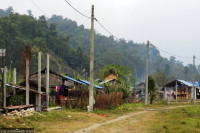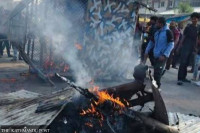National
Differences widen between bar and Judicial Council over judges’ appointment
Nepal Bar Association is unhappy with the role of its representative at the council and says he no longer has its trust.
Post Report
The Nepal Bar Association and the Judicial Council have drifted further apart following the appointment of high court judges and the amendment to the council’s regulations.
As the council was preparing to appoint high court judges, the association, an umbrella body of lawyers, on Wednesday morning summoned Ram Prasad Shrestha, a member representing lawyers at the council. However, Shrestha refused to show up.
As a result, a meeting of the lawyers’ body announced that it has no trust in Shrestha as he has failed to represent the lawyer community in the council.
“The meeting concluded that the Nepal Bar Association has no trust in Shrestha,” said Gopal Krishna Ghimire, president of the association. “It’s up to him [Shrestha] whether to resign on moral grounds or to continue to hold the position even after the institution that recommended him no longer wants to see him there.”
The five-member Judicial Council led by the chief justice nominates judges and justices. The law minister, the senior most Supreme Court justice and two advocates picked one each by the Nepal Bar Association and the government are its members. Shrestha, on the recommendation of the association, became a member of the council in November 2020. He still has 10 months of his tenure. He can be sacked only after impeachment by Parliament.
Senior advocates say the association’s representative is believed to speak their voice at the council. Shrestha, according to them, has failed to represent the lawyers’ community in the council.
“The Bar Association has every right to criticise its representative if he fails to promote its interest at the council,” said senior advocate Dinesh Tripathi, chairperson of the Constitutional Lawyers’ Forum. “Its decision will create moral pressure on Shrestha to quit but there is no way other than impeachment to unseat him.”
The association has stood against the council ever since it amended the regulation to change the order of precedence of the judges. The council in September revised the regulations, changing the ranking of the judges. The amendment published in the Nepal Gazette on September 20 states that the chief registrar of the Supreme Court would be ranked right under the chief judge of the high court if s/he is nominated as the high court judge.
The council last week appointed Lal Bahadur Kunwar, the apex court chief registrar, as the high court judge and accorded him the second rank—after the chief judge of Patan High Court. The association claims that the regulation makes the judges appointed from among the lawyers as second-class judges as the career judges get the upper ranks.
Differences between the two organisations widened following the appointment of the high court judges on Wednesday. A meeting of the council led by Chief Justice Bishowambhar Prasad Shrestha promoted 26 district court judges to high court positions. Four joint secretary-level officials under judicial service too have been picked for high court judges. Only nine lawyers were nominated judges.
The association had demanded that half of the judges be appointed from among lawyers.
In the hierarchy, all those appointed to the high court from the lawyers’ category are ranked lower to those promoted from the district court judges or picked from the judicial service.
Talking to the Post on Wednesday, Ghimire had said they were dissatisfied at the way the council functioned. The association plans to launch one more protest calling for a restructuring of the entire judiciary. The association has formed a committee to suggest the overall restructuring. An extended meeting of the association in May will endorse the report and devise the strategy for protest.




 9.12°C Kathmandu
9.12°C Kathmandu












%20(1).jpg&w=300&height=200)

